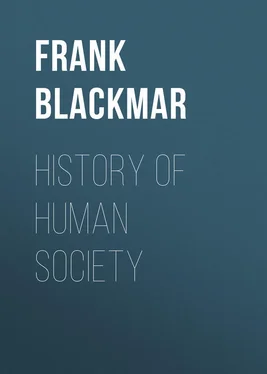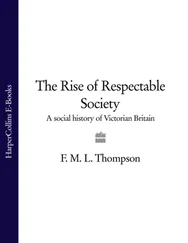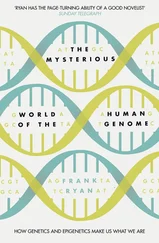Frank Blackmar - History of Human Society
Здесь есть возможность читать онлайн «Frank Blackmar - History of Human Society» — ознакомительный отрывок электронной книги совершенно бесплатно, а после прочтения отрывка купить полную версию. В некоторых случаях можно слушать аудио, скачать через торрент в формате fb2 и присутствует краткое содержание. ISBN: , Жанр: foreign_antique, foreign_prose, на английском языке. Описание произведения, (предисловие) а так же отзывы посетителей доступны на портале библиотеки ЛибКат.
- Название:History of Human Society
- Автор:
- Жанр:
- Год:неизвестен
- ISBN:http://www.gutenberg.org/ebooks/30610
- Рейтинг книги:3 / 5. Голосов: 1
-
Избранное:Добавить в избранное
- Отзывы:
-
Ваша оценка:
- 60
- 1
- 2
- 3
- 4
- 5
History of Human Society: краткое содержание, описание и аннотация
Предлагаем к чтению аннотацию, описание, краткое содержание или предисловие (зависит от того, что написал сам автор книги «History of Human Society»). Если вы не нашли необходимую информацию о книге — напишите в комментариях, мы постараемся отыскать её.
History of Human Society — читать онлайн ознакомительный отрывок
Ниже представлен текст книги, разбитый по страницам. Система сохранения места последней прочитанной страницы, позволяет с удобством читать онлайн бесплатно книгу «History of Human Society», без необходимости каждый раз заново искать на чём Вы остановились. Поставьте закладку, и сможете в любой момент перейти на страницу, на которой закончили чтение.
Интервал:
Закладка:
Mr. Clark Wissler has shown in his book on Man and Culture that there are culture areas originating from culture centres. From these culture centres the bow-and-arrow is used over a wide area. The domestication of the horse, which occurred in central Asia, has spread over the whole world. So stone implements of culture centres have been borrowed and exchanged more or less throughout the world. The theory is that one tribe or race invented one thing because of the adaptability to good environment. The dominant necessity of a race stimulated man's inventive power, while another tribe would invent or discover some other new thing for similar reasons. But once created, not only could the products be swapped or traded, but, where this was impossible, ideas could be borrowed and adapted through imitation.
However, one should be careful not to make too hasty generalizations regarding the similar products in different parts of the world, for there is such universality of the traits of the human mind that, with similar stages of advancement and similar environments, man's adaptive power would cause him to do the same thing in very much the same way. Thus, it is possible for two races that have had no contact for a hundred thousand years to develop indigenous products of art which are very similar. To illustrate from a point of contact nearer home, it is possible for a person living in Wisconsin and one in Massachusetts, having the same general environment – physical, educational, ethnic, religious – and having the same general traits of mind, through disconnected lines of differentiation, to write two books very much alike or two magazine articles very much alike. In the question of fundamental human traits subject to the same environmental stimuli, in a general way we expect similar results.
With all this differentiation, progress as a whole represents a continuous change from primitive conditions to the present complex life, even though its line of travel leads it through the byways of differentiation. Just as the development of races has been through the process of differentiation from an early parent stock, cultural changes have followed the same law of progressive change. Just as there is a unity of the human race, there is a unity of progress that involves all mankind.
The Study of the Uncultured Races of To-Day . – It is difficult to determine the beginnings of culture and to trace its slow development. In accomplishing this, there are two main methods of procedure; the first, to find the products or remains of culture left by races now extinct, that is, of nations and peoples that have lived and flourished and passed away, leaving evidence of what they brought to the world; also, by considering what they did with the tools with which they worked, and by determining the conditions under which they lived, a general idea of their state of progress may be obtained. The second method is to determine the state of culture of living races of to-day who have been retarded or whose progress shows a case of arrested development and compare their civilization statistically observed with that of the prehistoric peoples whose state of progress exhibits in a measure similar characteristics to those of the living races.
With these two methods working together, more light is continually being thrown upon man's ancient culture. To illustrate this, if a certain kind of tool or implement is found in the culture areas of the extinct Neanderthal race and a similar tool is used by a living Australian tribe, it may be conjectured with considerable accuracy that the use of this tool was for similar purposes, and the thoughts and beliefs that clustered around its use were the same in each tribe. Thus may be estimated the degree of progress of the primitive race. Or if an inscription on a cave of an extinct race showed a similarity to an inscription used by a living race, it would seem that they had the same background for such expression, and that similar instincts, emotions, and reflections were directed to a common end. The recent study of anthropologists and archaeologists has brought to light much knowledge of primitive man which may be judged on its own evidence and own merits. The verification of these early cultures by the living races who have reached a similar degree of progress is of great importance.
The Study of Prehistoric Types . 1 1 See Chapter IV .
– The brain capacity of modern man has changed little since the time of the Crô-Magnon race, which is the earliest ancestral type of present European races and whose existence dates back many thousand years. Possibly the weight of the brain has increased during this period because of its development, and undoubtedly its power is much greater in modern man than in this ancient type. Prior to that there are some evidences of extinct species, such as Pithecanthropus Erectus, the Grimaldi man, the Heidelberg man, and the Neanderthal. Judging from the skeletal remains that have been found of these races, there has been a general progress of cranial capacity. It is not necessary here to attempt to determine whether this has occurred from hereditary combinations or through changing environment. Undoubtedly both of these factors have been potential in increasing the brain power of man, and if we were to go farther back by way of analogy, at least, and consider the Anthropoid ape, the animal most resembling man, we find a vast contrast in his cranial capacity as compared with the lowest of the prehistoric types, or, indeed, of the lowest types of the uncultured living races.
Starting with the Anthropoid ape, who has a register of about 350 c.c., the Pithecanthropus about 900 c.c., and Neanderthal types registering as high as 1,620 c.c. of brain capacity, the best measures of the highest types of modern man show the brain capacity of 1,650 c.c. Specimens of the Crô-Magnon skulls show a brain capacity equal to that of modern man. There is a great variation in the brain capacity of the Neanderthal race as exhibited in specimens found in different centres of culture, ranging all the way from 1,296 c.c. to 1,620 c.c. Size is only one of several traits that determine brain power. Among others are the weight, convolutions, texture, and education. A small, compact brain may have more power than a larger brain relatively lighter. Also much depends upon the centres of development. The development of the frontal area, shown by the full forehead in connection with the distance above the ear (auditory meatus), in contrast with the development of the anterior lobes is indicative of power.
It is interesting to note also that the progress of man as shown in the remnants of arts and industry corresponds in development to the development of brain capacity, showing that the physical power of man kept pace with the mental development as exhibited in his mental power displayed in the arts and industries. The discoveries in recent times of the skeletons of prehistoric man in Europe, Africa, and America, and the increased collection of implements showing cultures are throwing new light on the science of man and indicating a continuous development from very primitive beginnings.
Progress Is Indicated by the Early Cultures . – It is convenient to divide the early culture of man, based upon his development in art into the Paleolithic, or unpolished, and the Neolithic, or polished, Stone Ages. 2 2 See Chapter III .
The former is again divided into the Eolithic, Lower Paleolithic, and the Upper Paleolithic. In considering these divisions of relative time cultures, it must be remembered that the only way we have of measuring prehistoric time is through the geological method, based upon the Ice Ages and changes in the physical contour of the earth.
In the strata of the earth, either in the late second inter-glacial period or at the beginning of the third, chipped rocks, or eoliths, are found used by races of which the Piltdown and Heidelberg species are representatives. 3 3 See Chapter IV .
Originally man used weapons to hammer and to cut already prepared by nature. Sharp-edged flints formed by the crushing of rocks in the descent of the glaciers or by upheavals of earth or by powerful torrents were picked up as needed for the purpose of cutting. Wherever a sharp edge was needed, these natural implements were useful. Gradually man learned to carry the best specimens with him. These he improved by chipping the edges, making them more serviceable, or chipping the eolith, so as to grasp it more easily. This represents the earliest relic of the beginning of civilization through art. Eoliths of this kind are found in Egypt in the hills bordering the Nile Valley, in Asia and America, as well as in southern Europe. Perhaps at the same period of development man selected stones suitable for crushing bones or for other purposes when hammering was necessary. These were gradually fashioned into more serviceable hammers. In the latter part of this period, known as the pre-Chellean, flint implements were considerably improved.
Интервал:
Закладка:
Похожие книги на «History of Human Society»
Представляем Вашему вниманию похожие книги на «History of Human Society» списком для выбора. Мы отобрали схожую по названию и смыслу литературу в надежде предоставить читателям больше вариантов отыскать новые, интересные, ещё непрочитанные произведения.
Обсуждение, отзывы о книге «History of Human Society» и просто собственные мнения читателей. Оставьте ваши комментарии, напишите, что Вы думаете о произведении, его смысле или главных героях. Укажите что конкретно понравилось, а что нет, и почему Вы так считаете.












